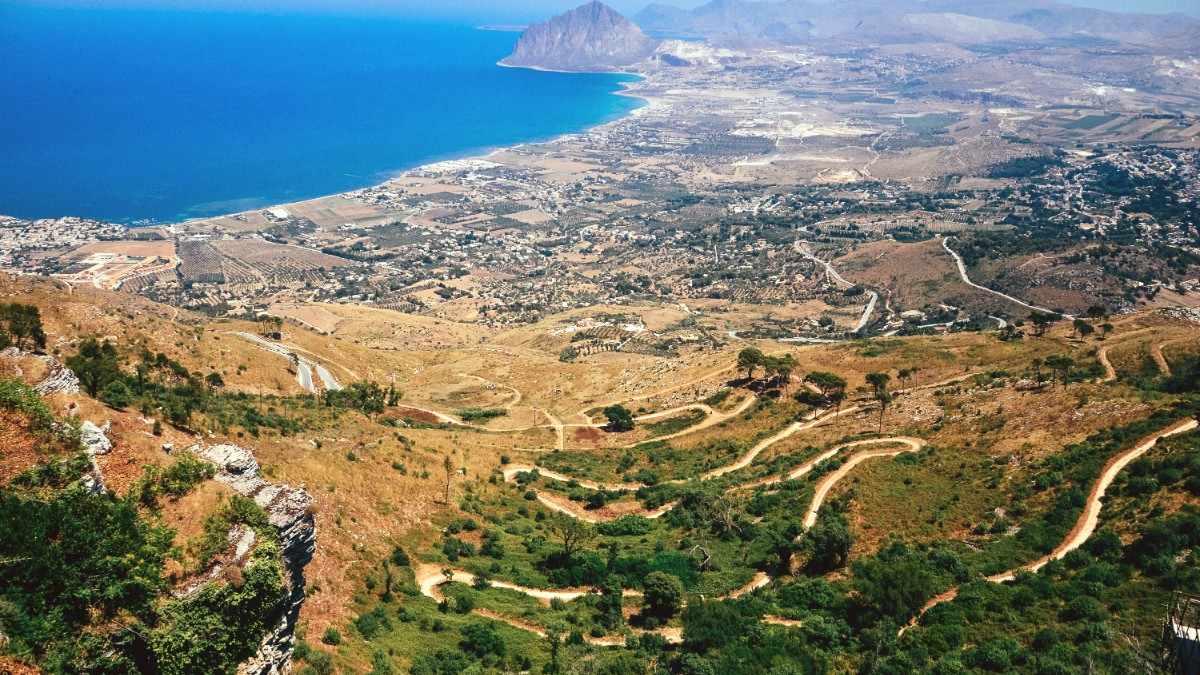
Sicily, Italy
This strategic position at the westernmost point of Sicily historically shaped Trapani's importance as a port. Its proximity to North Africa and direct access to major Mediterranean shipping lanes made it a valuable trading post and naval base for centuries. The peninsula itself is relatively flat, contrasting sharply with the mountainous terrain inland. This flat coastal plain fostered the development of its famous salt pans, which shaped the local economy and landscape for generations.
The interplay of land and sea creates a distinctive environment, influencing the climate, the local economy, and daily life. Consistent sea breezes moderate summer heat, keeping the air fresh.
The surrounding waters teem with marine life, directly supporting the city's long-standing fishing industry. Views from the city's western tip include the Egadi Islands, silhouetted on the horizon.
During the First Punic War (264-241 BC), Trapani gained prominence as a Carthaginian naval base. Its strategic harbor made it a valuable asset in the conflict between Carthage and Rome. Following the Carthaginian defeat, Trapani became a Roman possession. Under Roman rule, the city continued as a port, facilitating trade and military movements.
The Middle Ages brought new eras of prosperity. Arab rule, beginning in the 9th century, transformed Trapani into a flourishing trading center. The Arabs introduced new agricultural techniques, culinary traditions, and architectural styles, many still evident today. The city became known for salt production, a valuable medieval commodity, alongside coral and tuna. This period made Trapani a hub for maritime commerce, connecting Europe with North Africa and the Levant.
Strategic Carthaginian naval base.
Continued as an useful port for trade and military.
Flourishing trading center, new cultural contributions.
Integrated into the Kingdom of Sicily, further prosperity.
Architectural landmarks, enduring cultural mark.
Trapani's historical role as a gateway to North Africa and a hub for Mediterranean trade shaped a distinctive cultural and culinary legacy. The city's cuisine features ingredients and flavors from across the Mediterranean, a direct result of centuries of exchange.
Fishing remains a prominent industry, with the local fleet bringing in fresh seafood daily, directly influencing the city’s culinary scene. Salt production continues, using traditional methods in the historic salt pans that fringe the city. Wine production, especially of local varietals like Grillo and Nero d'Avola, and the fortified Marsala wine, represents a significant agricultural sector.
Tourism grew considerably, a major driver of the local economy, supporting hotels, restaurants, and tour operators.
Trapani presents a blend of natural beauty, historical depth, and local authenticity. Its manageable size and concentrated attractions make it a destination that visitors explore without feeling rushed, fostering a connection with local life.
Trapani presents a blend of natural beauty, historical depth, and local authenticity. Here is a brief overview of the city's characteristics and offerings:
Approximately 55,000 residents live within the city proper. The population density favors easy navigation of the city center.
The Port of Trapani serves as a transportation hub. It features frequent ferry connections to the Egadi Islands, rendering them accessible for day trips. Additionally, it services Pantelleria and mainland Italy (Naples), and sometimes Tunis. The port also hosts cruise ships, bringing international visitors.
Italian is the official language. A strong Sicilian dialect is widely spoken among locals. English is spoken in tourist-focused areas, but a few basic Italian phrases aid daily interactions and show respect for local culture.
Salt pans (Saline di Trapani e Paceco Nature Reserve), Erice (medieval hilltop town), Egadi Islands (Favignana, Levanzo, Marettimo), Torre di Ligny, Museo Regionale Agostino Pepoli, and the Historic city center.